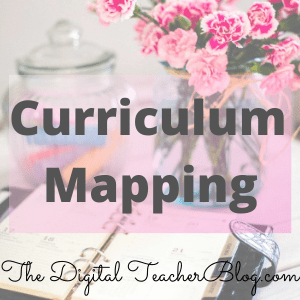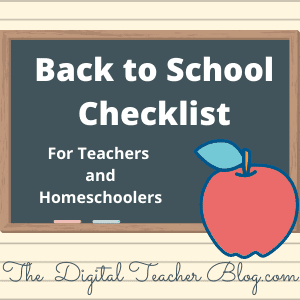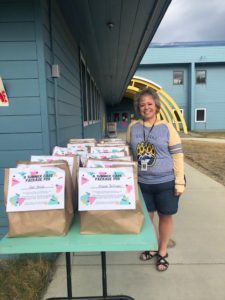New Year: Back to School Time!
Beginning a new school year in the middle of a health pandemic is going to be a unique experience. How is your district reopening schools? Do parents have options? Do teachers have options? How will the first day of school operate in the brick and mortar setting or online? What will you do to ensure the safety of students and yourself in the classroom? How will you provide a solid, rigorous learning environment in light of the new challenges as we reopen school this fall? These are some of the watercooler questions educators are discussing and searching for answers. One thing we know for sure, schools will reopen in some shape and form, and based upon our prior experiences and current health trends, teachers will need to have “pivot ready lessons” to meet each student’s learning needs.
This post may contain affiliate links, and I may earn compensation when you click on the links at no additional cost to you.

New Year: COVID-19 History
Last December, we knew there were concerns coming out of China regarding this virus; however, we didn’t realize how quickly it would spread around the world. Now we have a lot of questions with answers that seem to be more fluid than certain. So . . . how did we get to this point in our educational situation? Let’s take a look . . .
-
As a result of the 2019-2020 school year, specifically the 4th quarter with limited learning, this year educators will need to take a look at the curriculum that did not get completed from the prior grade level to begin instruction this school year.
-
Although some students were able to complete the 2019-2020 grade level program, this expectation will not hold true for all students.
-
On top of these instructional challenges, school is opening with many uncertainities, as the COVID cases continue to surge nationwide.
Besides the watercooler questions and concerns stated, educators are asking more questions as we count down the weeks before school begins.
-
How are teachers going to figure out where the students left off in the curriculum?
-
What are some strategies to accelerate the curriculum to ensure students solidify prior standards and are ready for new learning?
-
While the calendar keeps ticking away and school will begin, how can teachers prepare for a successful start in the midst of uncertainity, anxiety, and confusion about the best way to reopen schools?
Although we continue to have a plethora of questions about the learning environments, one area we can have more control over is planning for a fabulous instructional program.
New Year: Planning is the First Step for a Successful Year
In order to better plan a school year, take time to write down all the “things” that need to be done prior to the first day or in that first week of school. I have shared my “Back to School Checklist” to get you started.
While some schools are starting with a traditional learning model, others are blended, and still other schools are engaging in distance learning. The first thing teachers need to do is think about the instructional format, academic and social expectations, and the specific needs for incoming students. Teachers know where the kids need to be at the end of the year and the knowledge that is present when beginning the year; however, this year, we know the present level of knowledge will be skewed.
An important task and time well spent for any educator is to develop a yearlong curriculum map. This map acts as the “travel guide” to ensure all points of interest are visited. As a result of the everchanging pandemic situation, not only will teachers need to have lessons ready for a traditional school experience, but these lessons need to be “pivot ready” to continue learning in a blended or remote learning environment. Using a curriculum map is the perfect guide to ensure that the required content is taught in a sequential process and students have had an opportunity to learn and solidify the skills and strategies necessary before advancing to the next grade level or learning opportunity.

New Year: How to Develop a Year-long Curriculum Map
Developing a curriculum map can be done in different ways. I’ve seen some general curriculum maps that outline the curriculum by sharing unit titles across a calendar and some very specific curriculum maps that provide lessons outlined by the day. Some curriculum maps even include details such as standards, read aloud books, learning games, and center ideas. However you decide to organize your year-long curriculum map is up to you. Just remember, the most important step is to take time to organize. Once you have your first curriculum map completed, save it. You can use this map as your starting point for developing future curriculum maps.
Get started on your curriculum map with my “How to Develop a Curriculum Map” video. Then enjoy access a FREE curriculum map in my Teachers Pay Teachers store, The Digital Teacher Store.
https://youtu.be/L-LgFl1dn-4
Get Your FREE Curriculum Map!!
New Year: Planning Resources
Once you have your curriculum map prepared, you are ready to begin thinking about planning the first week of school. Utilizing a great lesson plan book such as the NEW Back To School Collection (by Erin Condren) is a great resource to personalize your lesson plans for the upcoming year. I love how Erin’s planners can be adjusted to your specific needs on the cover and inside pages. These planners are a bit more spendy, but a great option. Another resource that I have used and tweaked over the years is a Teacher Notebook that I created a few years ago when I wasn’t quite ready to purchase an Erin Condren planning book. I print off the notebook and include standards, my gradebook, and any other planning resources as part of this spiral bound resource. I love using this We R Memory Cinch Book Binding tool for my own creations, as well as student book creations such as publishing books, calendars, gifts, and journals.
New Year: Instructional Resources
Now that you have your curriculum map completed and lesson plan resource ready to go, it’s time to start thinking about those lessons. Developing literacy and mathematical skills and strategies in PK-5 is a primary goal to build a solid conceptual foundation. I always review and use the following resources every year to ensure that I am developing a tight program and meeting the individual needs for my students.
 Words Their Way ~ This resource is divided up into sections that focus on the student’s developmental learning areas. Once you have assessed their phonemic awareness, learning centers can be created with the reproducible materials in this text. Monitor student learning with a midyear and/or end of year test. Additional assessments will naturally occur in daily written work.
Words Their Way ~ This resource is divided up into sections that focus on the student’s developmental learning areas. Once you have assessed their phonemic awareness, learning centers can be created with the reproducible materials in this text. Monitor student learning with a midyear and/or end of year test. Additional assessments will naturally occur in daily written work.

 Guiding Readers and Writers ~ I literally call this book my “literacy bible”! I highly recommend taking time to read this entire book, and then go back and use the twenty-ish lessons available to begin a reading workshop and a writing workshop. This text is full of tips, strategies, and MORE ideas to support a literacy rich workshop learning framework. I use these lessons as part of building my classroom learning environment each year. It’s totally worth checking this resource out!!
Guiding Readers and Writers ~ I literally call this book my “literacy bible”! I highly recommend taking time to read this entire book, and then go back and use the twenty-ish lessons available to begin a reading workshop and a writing workshop. This text is full of tips, strategies, and MORE ideas to support a literacy rich workshop learning framework. I use these lessons as part of building my classroom learning environment each year. It’s totally worth checking this resource out!!

 Best Practices ~ I highly recommend this book for all elementary teachers and homeschooling parents! I read this book, reflected upon my instructional practices, adjusted my practices, and continued to implement skills and strategies to meet my students’ needs. I also used this book as a guide towards demonstrating accomplished teaching practices via earning National Board Certification. This is a must read for all curriculum areas!
Best Practices ~ I highly recommend this book for all elementary teachers and homeschooling parents! I read this book, reflected upon my instructional practices, adjusted my practices, and continued to implement skills and strategies to meet my students’ needs. I also used this book as a guide towards demonstrating accomplished teaching practices via earning National Board Certification. This is a must read for all curriculum areas!
New Year: Tips About Preassessments
Starting the year off with some preassessments will help guide the instruction that will take place this first quarter. We know that our students will be coming to us with a variety of accomplishments and needs. With a preassessment in hand, teachers will likely go back to the prior grade level standards and build lessons to ensure the foundation is set for new grade level content. This year will be especially important to assess current knowledge.
Here is a list of preassessments that you’ll want to use to learn as much as you can about each student. In an upcoming post, I’ll go into more details and come back to link this post. However, this information will certainly get you started.
Reading ~ Take time to listen to each student read individually. Tape record the student reading, so you can complete a miscue analysis to determine strengths and weaknesses.
Writing ~ Take time to provide a variety of writing opportunities: self-choice writing, response to a text, or a writing prompt provided. Each of these writing opportunities will provide enough information to identify areas that you can highlight for mini-lessons.
Spelling ~ I always us the “Words Their Way” spelling assessment. Once this assessment is completed, I code the assessment to determine where I need to begin working with students to develop skills.
Math ~ Take some time to assess student learning from the prior grade. Some math programs have an “end of year” assessment. I would pull the prior year’s assessment to assist in determining concepts students need to work on.
Taking the time to learn more about your students’ present level of achievement in order to develop an instructional sequence is key to begin focusing on learning. With this information, depending upon the significance of additional skill work required, you may need to tweak the curriculum map a tad. Did you go get the FREE curriculum map? Don’t wait!!!
New Year: Related Resources
Reopening Schools During a Health Pandemic – COVID-19
Educator Coaching Opportunity
What is 21st Century Pedagogy?
How to Launch an Amazing Year
New Year: Final Thoughts
We don’t know what this school year will bring or how this year is going to end. Who would have thought the 2019-2020 fourth quarter would have ended the way it did. However, one thing we do know is to be prepared and flexible with “pivot ready” lessons. Planning a school year with rigorous and effective learning experiences is what educators plan to do regardless of the learning environment.
Let’s have a fabulous year!











I’m a recently retired high school math teacher….great tips here to start the new school year!
Here we go again. Thanks for helping us all figure out how to do our best!
Great ideas! This is such a difficult time. All of the unknowns and last minute left turns are worse that just making a plan!
My favorite thing to do to get ready for school was to do our school shopping. Getting all new notebooks and supplies was what I looked forward to every year.
My district announced a plan last Friday, however, our Governor is expected to break some news at tomorrow’s press conference that may change everything again. I have always believed that flexibility is one of the most important qualities of a good teacher, so I’m sure we’ll be able to tackle whatever the final plan is!
Our district decided to stick with online learning which a lot of people are not okay with right now. I just hope the kids can go back to school at some point this school year at least. We do hope the online learning takes off pretty well.
The spring quarter was a huge learning shift for many. Since we’ve had time to figure out the kinks, it should go a lot smoother. My district is going back traditional, but teachers are expected to be able to pivot lessons immediately. So . . . we’ll be doing a lot of “kid training” to make this happen.
I’m so thankful that I do not have to make this decision during this pandemic. My little one is only 1. I feel for the parents, students, and teachers during this difficult time!
This is great information for parents, especially this year when there really hasn’t been finalization of the way the school year will be going this year.
These are great tips for starting it off right! I have been trying to keep my kids’ minds activated so they don’t go down that summer slide. I think we will start in a good place
I certainly do not envy teachers, students, or families who are looking at school coming up soon. My kids are grown, otherwise surely I’d know, but…I haven’t even heard if schools in New Mexico are opening…and, the schools usually start here mid-August, so that’s just 2 weeks away!
Good luck, all.